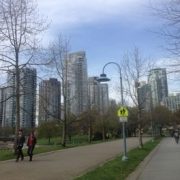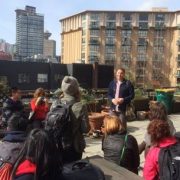Looking Beyond the Rose-Colored Glasses: A Critical Look at Vancouver’s Urban Design
Post by Naria Kiani and Rachel Lindt, MURP ’15 candidates
Vancouver’s urban design is an urban planner’s dream: dense towers with visual transparency, adjacent green space, and thoughtful spacing between buildings to ensure the preservation of site lines. Perhaps it was the wet weather or the fact that we are analytical urban planners, but we left this day with a critical view of aspects of Vancouver’s urban design. Through engaging conversation and interactive tours, we were left with two takeaways from the day.
Urban Design in Vancouver: Tunnel Vision or Long Range Planning?
Housing is huge in Vancouver. Tall podium style condominiums dominate the skyline. Throughout our meetings we were surprised by the little attention given to what has driven all the housing development in Vancouver. A few speakers made anecdotal comments about how they moved here for the city itself and its high livability. As planners we have to wonder about jobs. If people are coming here strictly for the urban design and livability of the city what sort of employment is there for them? This is a question of ours that is still unanswered, but one thing we are sure of is that people are attracted to this place and we don’t see preferences changing anytime soon.
The Importance of Context Sensitive Public Spaces
Drawing connections between Vancouver and Los Angeles often appears to be a daunting task. How can two cities so starkly different learn anything from one another? Los Angeles is sunny and warm and Vancouver is rainy and cold (most of the year). These two weather patterns have serious implications for urban design. Standing in the pouring rain listening to the design process of one of Vancouver’s parklets, we could not help but notice that no one was using the space. This made us realize how important it is for urban design to be context sensitive in order to allow spaces to be activated as often as possible. Perhaps if the City of Vancouver chose to add an awning over the parklet it would be used more often. Although Los Angeles does not have rain, the beating sun can make an Angeleno duck for cover. So here we have two cities with completely different weather yet both would benefit from an easy adjustment: an awning.















Leave a Reply
Want to join the discussion?Feel free to contribute!